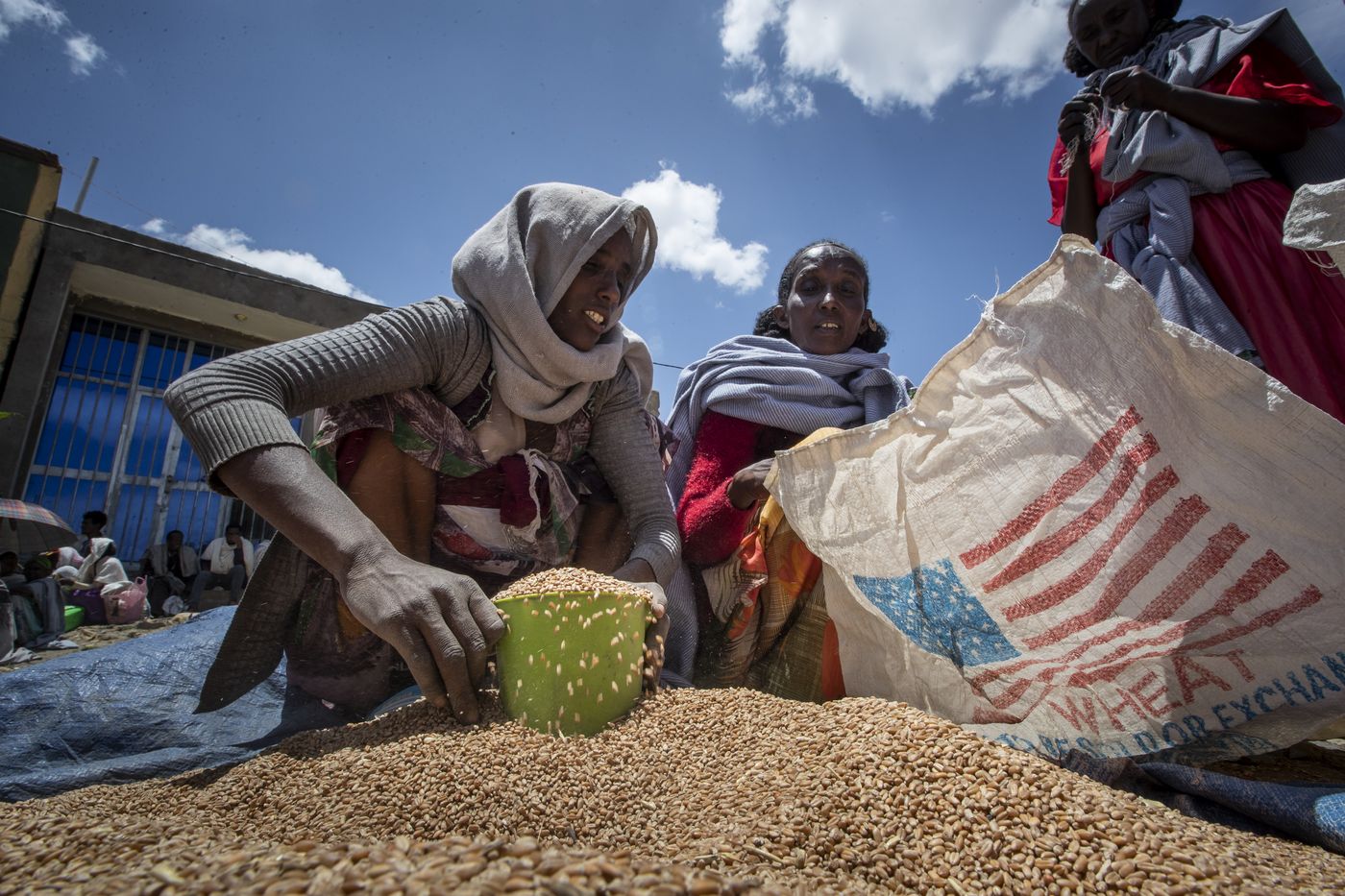The Ukraine war and food security in Africa: “Meeting the acute needs is not solving the general problem.”
Megatrends spotlight 2022 07, 16.05.2022Since the Russian invasion of Ukraine began, we have been witness to a humanitarian catastrophe unfolding in the Black Sea region. At the same time, another one is already looming on the horizon in many African countries. The loss of grain and food imports means that it will be more difficult for Africans to obtain these goods and, above all, pay for them. We spoke to agricultural economist Bettina Rudloff (SWP) about why food security in Africa is often dependent on imports and what options for action exist for African and international actors. She argues that we already have valuable initiatives and tools at our disposal, but we lack a strategic approach. Cooperation with so-called non-traditional humanitarian donors such as China is also an option.

Humanitarian aid organizations distribute wheat rations to families in Ethiopia's Tigray region in May 2021.
© picture alliance / ASSOCIATED PRESS | Ben Curtis
AH: Ms. Rudloff, what short-term and long-term consequences can be expected from a lack of or reduction in grain imports? Perhaps you could briefly outline which processes will be triggered by this.
BR: In the short term, physical and planned supply volumes will be lost. Countries such as Egypt count on certain import quantities. This does not mean that these goods are not available someplace else. But while Egypt and others now have to look for immediate replacements, the prices of the goods they want are rising for everyone else as well.
In the long run, the market will react and expand to provide more economically attractive products due to higher prices. But now we can’t just frantically start reseeding. This is the problem with the agricultural sector. You cannot press a button and automatically get more wheat. It will probably take more than a year to see reactions to the current situation. At the same time, the acreage is ultimately limited, and you can’t stockpile indefinitely either, because these are basically perishable products.
AH: So, there are enough goods out there. But is it a question of money as to whether one can afford to import them?
BR: That’s what everyone wants to know right now: Are the quantities sufficient overall? It is very difficult to get an overview of the total stocks of wheat worldwide. There are estimates, but we don’t know exactly. Some assume that this year’s gaps can be filled. However, we may see a more general problem afterwards – if only because of rising prices, and thus import costs.
The problem is not only the rising costs of imports, but the resulting increase in the number of people who are starving. We fear that countries will either not be able to find replacements quickly or that they will not be affordable to many. People will have less to eat. Estimates range from an additional 10 to 100 million people subject to starvation and hunger.
That is why everyone is focussing on what can be done now. “How can we replace the missing imports?” But the increase comes on top of a huge problem that has existed for decades: Currently, we have more than 800 million hungry people worldwide. Meeting these acute additional needs does not fundamentally solve the problem.
AH: What are the structural and historical causes for these dependencies on staple foods such as wheat?
BR: For North Africa, for example, we can say that it is a complex interplay of three factors: economic, political-cultural, and climatic.
From an economic point of view, the first decisive question is: Why do you source solely from one producer, one region? One factor is, of course, geographical proximity. North Africa, the Black Sea, the Mediterranean – they are all quite close to each other. It makes more sense to import from there than from Australia, for example.
Where established supply relationships have existed for a long time and in large quantities, it is likely that you can buy at better conditions or certain other benefits in the supply are offered additionally, such as consultations or warehouse support as part of the package. This makes a certain delivery origin attractive.
But this can create non-diversified supply chains. Diversification is actually a fundamental economic principle: If problems arise in precisely this one dominant supply relationship, things can get difficult. That is what we are seeing right now. Even more important than pure numerical diversification towards a greater number of supply sources is the ability to react flexibly and quickly in case of difficulties.
AH: Why do African countries have to import grain most of the time? What are the basic circumstances that lead to this situation?
BR: Some African countries need grain of specific commercial classes, for example in terms of moisture. Because of the storage conditions, Egypt, for example, used to buy such grades from Ukraine and Russia and is now, for the first time, switching to French wheat of a different commercial class.
One problem is the climatic conditions. Relying on grain for food in North Africa means being dependent on imports. But African production also suffers from the fact that its own political priority for the agricultural sector has never been high. For decades, there has been an African Union agreement to commit 10 per cent of public spending to agriculture – the so-called Maputo target. But only individual countries keep to this agreement.
AH: How does the insecurity of supply affect the relationship between the civilian population and the state?
BR: Bread prices have an insane symbolic power. We also saw that in the Arab Spring. It was also about energy costs, housing costs, and a general dissatisfaction with the political system. But bread is a kind of guiding symbol. Political actors therefore have the reflex to keep the price of bread stable. For this reason, North African states have introduced bread subsidies. Low prices then have a positive effect on consumers, but they are bad for producers, especially in the absence of other production support. It is mostly about the urban populations. People are worried about possible unrest.

Bettina Rudloff works on issues related to global nutrition, agricultural and trade policy at the German Institute for International and Security Affairs in Berlin.
© Stiftung Wissenschaft und Politik
AH: The first pictures of this year’s famines are reaching us from Somalia. The current crisis comes on top of this. At the beginning of April, the International Committee of the Red Cross warned that a famine crisis would threaten many African states this year. Violent conflict meets drought in East Africa, while West African states are hit by poor rainfall levels, a rising number of displaced people, and price inflation. Not to mention the impact of the pandemic. Is the Zero Hunger goal out of reach?
BR: Yes, exactly. I think it’s important to emphasise that the recent war-driven food risk is something acute now. Policy tends to focus on solving the acute challenge. That is, of course, also important. But the longer-term challenges are often forgotten.
The FAO, the UN Food and Agriculture Organization, states that exactly conflicts are increasingly relevant or the determining cause of hunger. The war against Ukraine is a particularly dramatic war-induced supply risk, as it involves a huge agricultural exporter. Thus, in addition to the risk to its own food supply, it is also a risk for third countries. But in principle, all conflicts are a prevailing factor when it comes to hunger.
What can be done now? Well, we simply have to raise a lot of money quickly in support of the humanitarian sector, for example. Aid organisations also have to pay higher prices for grain – they put it at USD 70 million per month more.
Above all, one has to invest in production in the places and regions that still have potential for the most decisive factor of scarcity – land. There is potential for that in Africa. With more supply-essential products globally, the market would not be so tight and would not react so quickly to crises with high price spikes – we would see a larger buffer and also more supply.
AH: The humanitarian sector has long complained about a funding gap. Where could more money come from? Now, the EU and China have announced their intentions to increase cooperation in the area of food security following their last summit in April. Could this be an option?
BR: It would definitely be worth a try. Even aside from the money, and especially with China. It is estimated that about 50 per cent of the world’s grain stocks are in China. The other big agricultural player, by the way, is India. We should at least try to develop constructive partnerships and cooperation mechanisms with these actors. Perhaps along the lines of: We take care of transport and logistics, and you contribute with your inventories. This topic is being neglected in the current discussion.
AH: What possibilities for adaptation do the affected countries have themselves?
BR: In the medium term, it would be central for the African side to rediscover the Maputo target and its own commitment to the agricultural sector. The other important element is regional cooperation. There are already local initiatives for cross-country reserve management, for example the RESOGEST programme in West Africa, which is also co-funded by the EU. Unfortunately, such approaches are often forgotten after acute crises have subsided. But it could now be revived and expanded to other regions. After all, many other forms of aid have already been in place for decades. Of course, African states must set their own priorities, but one can always ask how this can be supported and what would hamper implementation.
AH: Which aspects have been given too little attention in the discussion on this topic so far?
BR: The topic of early warning and monitoring. There is the Agricultural Market Information System (AMIS), for example. It was launched by the G20 during the last crisis in 2011 and is supposed to continuously monitor where shortages are occurring and where supplies are sufficient. The G20 used the system, especially during the pandemic, as part of a communication campaign against export restrictions.
Unfortunately, such restrictions are THE reflex to crises. One can only repeat over and over that it is in one’s own interest to refrain from introducing such measures. It puts downward pressure on domestic prices. In the long run, you also harm your own producers because you reduce their productivity levels and planning security. But politically it is used as an important signal: “Our population is a top priority” – even if it harms others.
We also have to stop looking only at the end products and begin to think more strategically. What about fertilisers, the stability of supply chains and transport routes, where are logistical bottlenecks? It should be clearer where the crucial hubs are for certain product deliveries and for certain regions. Actually, everything is there to realise that. It is perhaps more about a change in mindset towards a more strategic approach to the issue of security of supply – one that looks beyond volume availability and prices.
Interview conducted by Anna Hörter, research assistant for external communications in the "Megatrends Afrika" project.